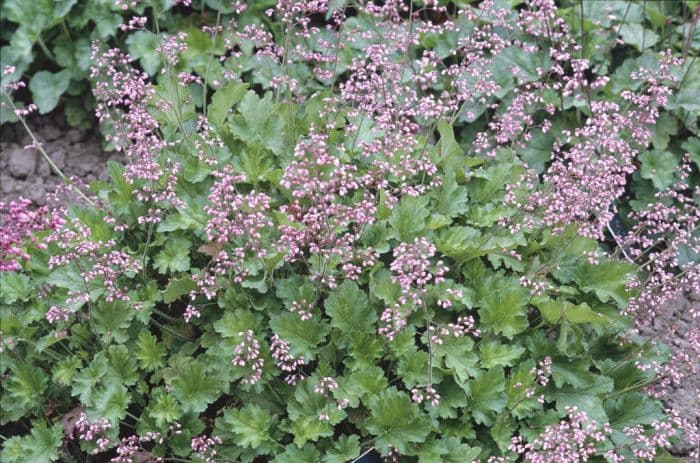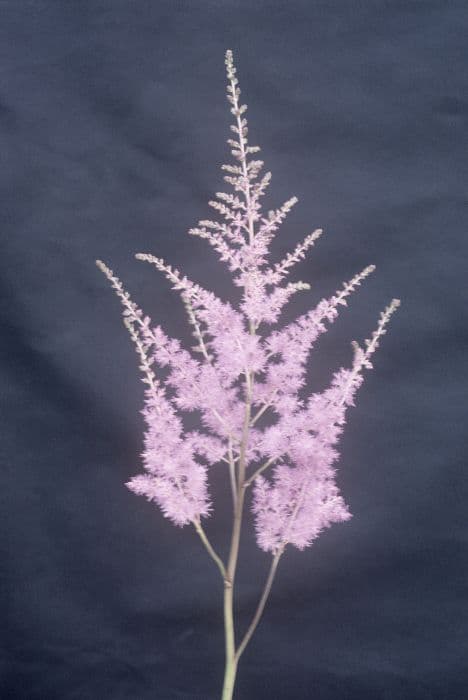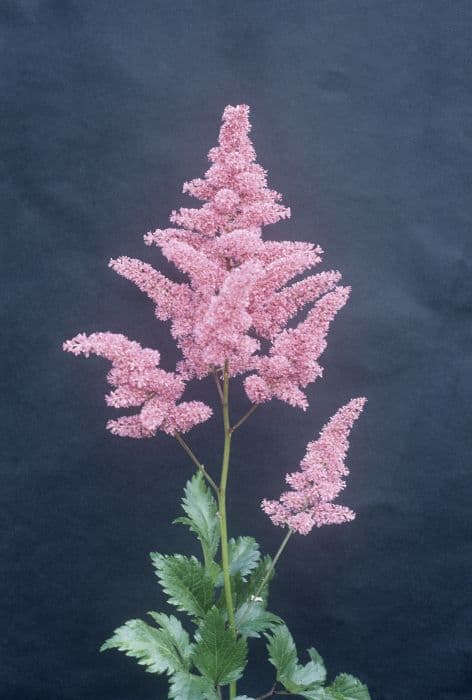Coral Bells Heuchera 'Strawberry Swirl'

ABOUT
Heuchera 'Strawberry Swirl' is an ornamental perennial known for its striking foliage and dainty flowers. The plant features a rosette of leaves, each leaf characterized by a unique pattern. The foliage boasts an array of colors, often displaying shades of green, silver, and deep burgundy. The leaves are rounded, with a gently lobed edge that gives them a ruffled appearance. In contrast to the dark tones of the foliage, the surface of the leaves may exhibit lighter veining, creating a marbled effect that resembles a strawberry swirl, hence the name. Above the attractive mound of leaves, slender stems rise to bear small bell-shaped flowers. These blossoms are typically a soft, creamy white or pale pink, adding a delicate touch of color and contrasting nicely with the dramatic foliage below. The flowers are borne in loose, airy clusters, swaying gracefully in the breeze and attracting pollinators. During different seasons, Heuchera 'Strawberry Swirl' can undergo transformations in color intensity and shading, contributing to its charm and making it a dynamic element in any garden setting. Its vibrant leaves provide year-round interest, thriving in both sunny and partly shaded conditions and displaying a resilience that makes it a favorite among gardeners looking for long-lasting visual appeal.
About this plant
 Names
NamesFamily
Saxifragaceae
Synonyms
Coral Bells, Alumroot
Common names
Heuchera 'Strawberry Swirl'.
 Toxicity
ToxicityTo humans
The common name for Heuchera 'Strawberry Swirl' is Coral Bells. Coral Bells are not known to be toxic to humans. There are no well-documented cases of poisoning or symptoms directly related to ingesting any part of this plant. However, as with any plant material, ingesting non-food plants can potentially cause some individuals to experience adverse reactions due to allergies or sensitivities.
To pets
Coral Bells are not typically toxic to pets. There are no significant reports of poisoning in pets such as cats and dogs from ingesting this plant. While Coral Bells are generally considered safe, it's always wise to prevent your pets from eating plants since individual animals might have unique sensitivities or allergies that could cause mild gastrointestinal upset.
 Characteristics
CharacteristicsLife cycle
Perennials
Foliage type
Evergreen
Color of leaves
Mixed
Flower color
Pink
Height
1-2 feet (30-60 cm)
Spread
1-2 feet (30-60 cm)
Plant type
Herb
Hardiness zones
4-9
Native area
North America
Benefits
 General Benefits
General Benefits- Aesthetic Appeal: Adds vibrant color with its strawberry-hued foliage and white-pink flowers.
- Durability: Offers a robust and disease-resistant nature, making it a hardy garden addition.
- Maintenance: Requires minimal care, which is ideal for busy gardeners or those seeking low-maintenance landscapes.
- Long Bloom Season: Produces flowers from spring to summer, providing prolonged visual interest.
- Attracts Wildlife: Draws in beneficial pollinators such as butterflies and hummingbirds, enhancing biodiversity.
- Versatility: Suitable for a variety of garden settings, including borders, containers, and as ground cover.
- Texture Variety: Provides unique textural contrast to other plants in the garden with its intricate leaves.
 Medical Properties
Medical PropertiesThis plant is not used for medical purposes.
 Air-purifying Qualities
Air-purifying QualitiesThis plant is not specifically known for air purifying qualities.
 Other Uses
Other Uses- Photography Prop: Coral Bells can be used to add a pop of color and texture to garden photography, enhancing the visual appeal of photos.
- Artistic Inspiration: The vibrant foliage and delicate flowers of Coral Bells can serve as a muse for painters and illustrators seeking botanical inspiration.
- Education: Coral Bells can be included in educational programs at botanical gardens and schools to teach children about plant diversity and horticulture.
- Theme Gardens: They can be used in thematic garden designs, such as a 'strawberry' themed garden due to their name 'Strawberry Swirl' and their reddish foliage resembling the fruit.
- Fauna Habitat: Coral Bells can provide habitat and food for butterflies and hummingbirds, thus promoting biodiversity in the garden.
- Culinary Presentation: The leaves can occasionally be used as a decorative garnish for plates in high-end culinary presentations (though they are not edible).
- Eco-friendly Dye: The richly colored leaves could be explored for their potential to provide a natural dye for textiles, albeit not a traditional use.
- Frost Indicator: The first frosts can sometimes be detected on the delicate leaves of Coral Bells, acting as a natural indicator of temperature changes in a garden.
- Pottery Inspiration: Ceramic artists might use the intricate vein patterns of Coral Bells' leaves as inspiration for designs on pottery or sculpture.
- Floral Arrangements: While not their most common use, the attractive foliage and flowers of Coral Bells can be included in floral arrangements to add a unique texture and color contrast.
Interesting Facts
 Feng Shui
Feng ShuiThe Coral Bells is not used in Feng Shui practice.
 Zodiac Sign Compitability
Zodiac Sign CompitabilityThe Coral Bells is not used in astrology practice.
 Plant Symbolism
Plant Symbolism- Enduring Beauty: Heuchera, commonly known as Coral Bells, often symbolizes lasting beauty due to its attractive foliage that remains visually appealing throughout multiple seasons.
- New Beginnings: The perennial nature of Coral Bells, which can come back year after year, may represent rebirth and new beginnings.
- Variety and Versatility: The 'Strawberry Swirl' variety, with its unique variegated leaves, can symbolize the diversity and adaptability in life, suggesting a readiness for change and variety.
 Water
WaterCoral Bells should be watered regularly, aiming to maintain a consistently moist but not soggy soil. The frequency of watering depends on weather conditions and soil type, but generally, water once a week with approximately one gallon per plant per watering session during active growth in the spring and summer. During hot, dry periods, they may require additional water. In the fall and winter, reduce watering but do not let the soil dry out completely. It's best to water deeply and infrequently rather than little and often to encourage deep root growth.
 Light
LightCoral Bells thrive in a location with partial shade or filtered sunlight, although they can tolerate morning sun followed by afternoon shade. To maintain vibrant foliage color, avoid placing them in deep shade or in full sun, which can scorch the leaves or fade their color. The ideal spot would offer protection from the harsh midday sun while providing enough light to highlight their colorful leaves.
 Temperature
TemperatureCoral Bells are hardy and can survive in a wide range of temperatures. They can endure minimum temperatures down to around -25 degrees Fahrenheit, but the ideal growing conditions range between 60 and 70 degrees Fahrenheit. To prevent frost damage in cooler zones, provide adequate mulching around the base of the plant.
 Pruning
PruningCoral Bells require minimal pruning, mainly to remove any spent flower stalks and to tidy up any damaged or dead leaves. The best time for pruning is in the spring or right after flowering. Pruning is typically done annually, and by removing the old flower stalks, you encourage a bushier plant and possibly a second bloom.
 Cleaning
CleaningAs needed
 Soil
SoilCoral Bells, including Heuchera 'Strawberry Swirl', thrive in well-draining soil rich in organic matter with a pH range of 6.0 to 7.0. The best soil mix would be a combination of garden soil, peat moss or compost, and perlite or coarse sand for improved drainage.
 Repotting
RepottingCoral Bells typically do not need frequent repotting and can be repotted every 3 to 4 years, or if the plant has outgrown its current container.
 Humidity & Misting
Humidity & MistingCoral Bells prefer moderate humidity levels but are quite adaptable and can tolerate a range of humidity conditions typically found in home gardens without issue.
 Suitable locations
Suitable locationsIndoor
Place Coral Bells in bright, indirect light with well-draining soil.
Outdoor
Plant in part shade to full sun with moist, rich soil.
Hardiness zone
4-9 USDA
 Life cycle
Life cycleCoral Bells 'Strawberry Swirl' begins its life as a seed, which germinates in moist, well-draining soil during the cooler temperatures of late winter to early spring. The seedling develops into a rosette of foliage, with leaves featuring characteristic silver veins and strawberry-pink hues. As the rosette matures, the plant sends up flower stalks in late spring to early summer, boasting tiny bell-shaped flowers that attract pollinators. After flowering, seeds are set and dispersed, while the foliage remains ornamental throughout the growing season. In the winter, the plant enters a period of dormancy, with the foliage sometimes persisting in milder climates. The next growing season, Coral Bells 'Strawberry Swirl' may expand through clumping and can be divided to produce new plants.
 Propogation
PropogationPropogation time
Spring-Early Summer
The Coral Bells 'Strawberry Swirl', a perennial known for its attractive foliage and flowers, is commonly propagated by division. The best time to propagate Coral Bells is in spring or early fall to allow the plants time to establish themselves before the extremes of winter or summer. To propagate by division, carefully dig up the parent plant and separate it into smaller clumps, ensuring that each new section has a part of the root system and a few shoots. These clumps can then be replanted in the garden at the same depth they were growing previously, spaced around 12 to 18 inches (about 30 to 45 centimeters) apart to provide room for growth. Water the new divisions thoroughly after planting to help establish them. This method is effective for maintaining the vigorous health and the true characteristics of the 'Strawberry Swirl' variety.









